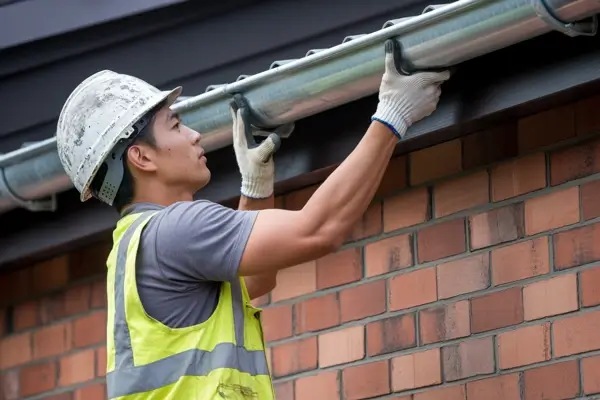Rain water goods Method Statement

This method statement for fitting rainwater goods is available as an instant download.
At the top of the first page, you can enter your company name and project details, and at the bottom, you can sign, print, and date it.
It couldn’t be easier. Once you’ve entered your details, you’re good to go.
You can customise the document to your company and needs by inserting your company name, logo, contract details, site address, etc…
The method statement becomes part of your branded H&S package.
Rainwater goods are important parts of a building's exterior that help collect and drain rainwater. They protect the building from moisture damage. This system comprises gutters, downpipes, and other components, including hopper heads, gully drainage systems, and rainwater harvesting systems.
Gutters are placed along the edges of the roof to guide rainwater as it falls. They stop water from pooling near the foundation or running down the walls.
Downpipes, also known as vertical soil pipes, connect to the gutters and direct rainwater to the ground or a drainage system. They often have bends and connectors to ensure water flows away from the building.
Hopper heads act as junction points, linking the gutters to the downpipes. They collect rainwater from a larger area of the roof and direct it into the downpipes for efficient water management.
Below-ground drains or collection points, such as soakaways or storm drains, help manage rainwater. They either direct it to the local drainage system or allow it to soak into the ground, reducing surface runoff.
Other parts of the rainwater goods system include fascia boards, soffits, and flashings. Fascia boards support the ends of roof rafters and provide a finished look. Soffits cover the underside of the eaves, providing ventilation and enhancing the appearance. Flashings are placed in vulnerable areas, like roof joints, to keep water away from these spots and prevent leaks.
Rainwater goods are crucial for protecting the building. They keep water from running down walls, which can lead to damage, mould growth, and material breakdown. Properly installed and maintained rainwater goods help a building last longer by managing rainwater and reducing water-related problems.
The method statement is:
- Recognised by local authorities
- Recognised by principal contractors
- Suitable for CDM sites
- Approved by H&S managers
It increases your chance of winning tenders and has been written by trained health and safety professionals.
If the method statement needs altering to include an additional task, such as:
“Ensure you sign and date the site register located in the welfare facilities prior to commencing work”
It can easily be added as the document comes in Word™, not PDF.
Once you buy and download this document, it’s yours for life to use repeatedly.
We’ve done the hard work for you, allowing you to give people confidence in you, your company, your products and services.
The scope of work that this method statement covers includes:
- Start of works
- Remove existing rainwater goods
- Fit new rainwater goods
- Finishing
Why not browse the HSEDocs catalogue of method statements, risk assessments, COSHH assessments, or industry-specific packages?
And for safety training relevant to your job, visit our online training courses.
GET THIS DOCUMENT
£8.99+VAT
- Available in Word™
- Fully customisable
- Add your Company Logo
- UK & EU Compliant

 CART
CART 